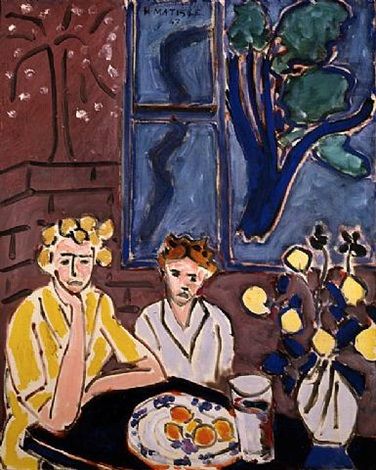Description
Henri Matisse, one of the giants of modern art, continues to amaze with his ability to reimagine the world through his distinctive palette of vibrant colors and bold compositions. In his painting "Two Girls, Blue Window" from 1947, we find a fascinating representation of his mature style, in which simplified forms and expressive use of color dominate the scene.
This work, of relatively modest dimensions at 38x47 cm, is a silent manifesto of the power of color and form. The composition is dominated by two female figures placed in front of a blue window, a detail that, although seemingly simple, serves as a powerful visual anchor. The two women are immersed in an intimate conversation or a moment of shared contemplation, creating a sense of calm and stillness that contrasts with the dynamism of the use of color in the work.
Matisse is often associated with Fauvism, a movement that celebrated color as a means of emotional expression independent of naturalistic reality. In "Two Girls, Blue Window," this influence is palpable. The blue of the window not only provides a cool and serene background but also serves as a unifying element that connects the different planes of the composition. This blue extends in shades throughout the painting, uniting the figures and the surrounding space in a chromatic harmony that is characteristically Matissean.
The female figures, although schematic in their stylization, convey a warmth and proximity that is almost tangible. This simplified and almost abstract representation of human anatomy is a hallmark of Matisse's late style, where detailed precision is sacrificed in favor of expression and emotion. The women's faces are not outlined in detail, suggesting that the essence of their presence is more important than their individual identity. Matisse thus ensures that the viewer focuses on the interaction and the overall atmosphere created by the scene.
The spatial arrangement also deserves special attention. The way Matisse handles perspective is unique; the blue window acts not only as a physical component of the environment but also as a portal that suggests a depth contrasting with the flatness of the figures and other elements of the composition. This play between the two-dimensional and the suggestion of a three-dimensional space is a testament to Matisse's mastery in visual manipulation.
To contextualize "Two Girls, Blue Window" within Matisse's broader work, it is crucial to remember his series of interiors and window portraits, where he repeatedly explored the dialogue between the interior and the exterior, between the individual and the world beyond. paintings such as "Open Window, Collioure" (1905) show an early predilection for the window motif, which develops in a more stylized and abstract manner in his later work, as seen here.
In summary, "Two Girls, Blue Window" is not just an exploration of the intimacy between two female figures but also a meditation on color, form, and space. Through this piece, Matisse invites us to see beyond the details and immerse ourselves in the visual rhythm created by the interaction of his pictorial elements. In its apparent simplicity, this work encapsulates the complexity and depth of Henri Matisse's artistic vision.

